
PUMPA - SMART LEARNING
எங்கள் ஆசிரியர்களுடன் 1-ஆன்-1 ஆலோசனை நேரத்தைப் பெறுங்கள். டாப்பர் ஆவதற்கு நாங்கள் பயிற்சி அளிப்போம்
Book Free DemoFeatures of British Urbanisation:
The arrival of the Europeans from the western part of the world to India changed the face of Urbanisation in India. They established new towns with designs from Europe. It also contained some special features, which are discussed below.
1. The Phase of De-Industrialisation:
During the \(17^{th}\) and the \(18^{th}\) Century, the British started to alter the course of Indian history. British entered the territory of India as traders and slowly gained control over the developed towns.
After the arrival of the British company, the native artisan economy was destroyed. India, which was a centre of Industrialisation during the \(17^{th}\) century, was slowly crippled by the advent of the Europeans.
This De-Industrialisation of the native artistic economy and its markets resounded around the world as the shining cities of Lucknow and Surat lost their prominence among the trade centres of the West.
The British levied high import duties and taxes for Indian goods, which drained India's economic wealth and destroyed the Indian handicraft industries.
2. The Europeans and De-Urbanisation:
After gaining the monopoly over the Indian handicrafts and cotton industry, the British later went on to use the Subcontinent as the producer of various raw materials.
The Draconian Policy of the British like the "Subsidiary Alliance and the Doctrine of Lapse” in the \(18^{th}\) and \(19^{th}\) century further crucified the Industries of Indian and the markets which dependent on India.
Subsidiary Alliance: The Policy of Subsidiary Alliance was established by Lord Wellesley, under which an Indian territory entering the alliance will be bought entirely under the control of the British Company.
The loss of powers of the Indian rulers like the Mughals, Marathas and the rulers of India and the loss of their territories to the British company further curtailed the urbanisation.
Various important centres like Agra, Jodhpur and Delhi were taken under British control. Old cities and towns didn't survive as they witnessed the shift in trade to new centres.
In the year \(1853\): The railways created by the British laid their first line of connection between the Indian cities of Mumbai and Thane.
The establishment of railway lines by the British further strengthened the network of the company for which lots of lands of the natives were acquired. These railways are points of export of raw materials to the nook and corner of the country.
This British move further decimated the native industries located in the villages, which the company exploited for their raw materials.
3. The Rise of New Urban Centres:
During the first half of the \(17^{th}\) century, the British converted the fishing hamlets of the coastal towns of east, west and the south of India.
They established new power centres in all three directions like the Calcutta in the East, Bombay in the West and Chennai in the South-east.

The battle of Plassey
Post the Battle of Plassey in \(1757\); the British brought entire North India under their control, allowing them to further expand their political and trade activities.
Battle of Plassey: This battle was fought in the year \(1757\) by the British company forces under the leadership of Robert Clive against the forces of Nawab of Bengal, where the Nawab’s forces were defeated.
After consolidating the position as the Supreme Power, the British started to build various new infrastructures that further defined the Urban Centres in India.